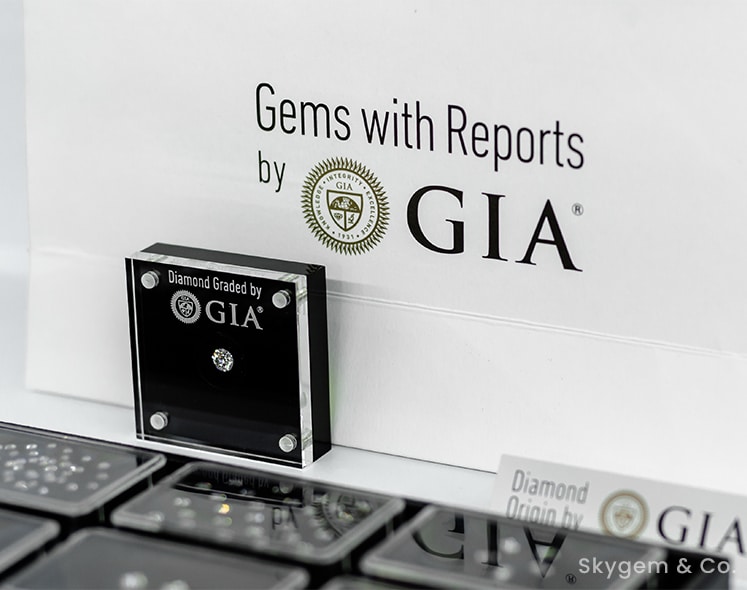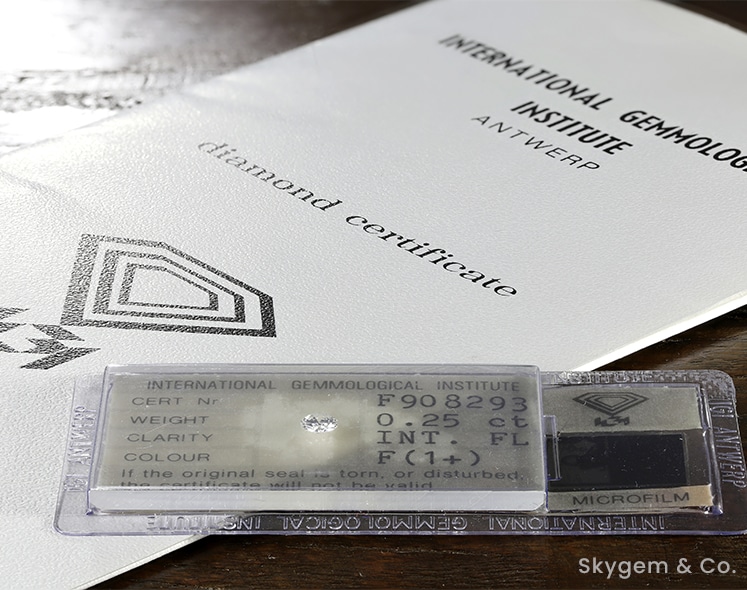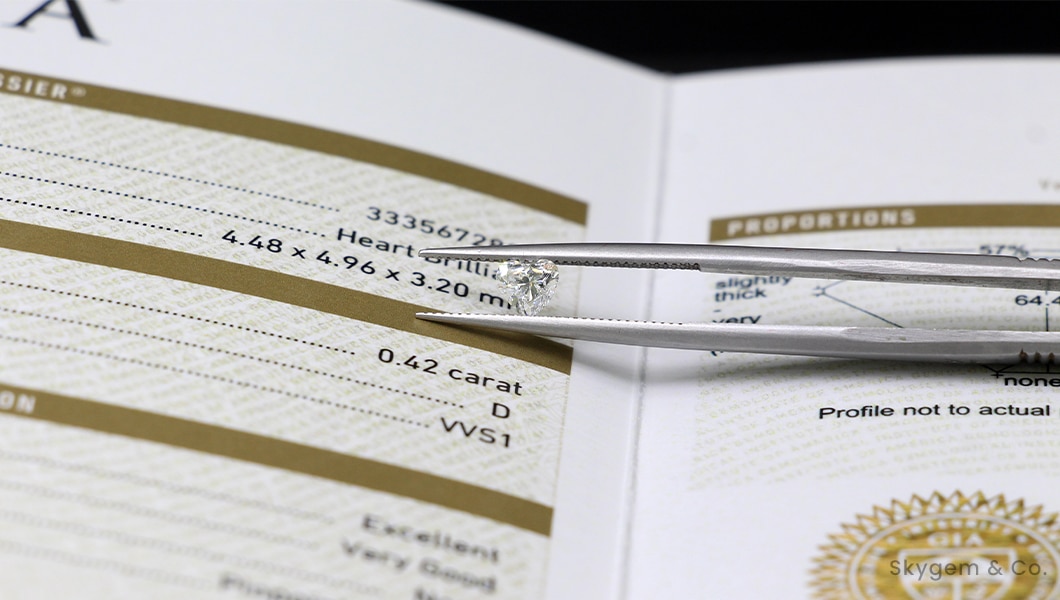Diamonds come in an assortment of shapes, sizes, cuts, and colours. The demand for this precious gem, especially for engagement rings and wedding bands, is such that several look-alikes, aka diamond simulants, have also overtaken the market. When shopping for this brilliant gem, it is not easy for most of us to differentiate between real and fake; this is where diamond certification comes in.In today’s article, we will discuss the most reputed diamond certifications available and how they help you make informed decisions.
What Exactly Does Diamond Certification Mean?
In the most basic terms, a diamond certification is a document that confirms the authenticity of a diamond by providing precise information on the 4Cs of the gem, i.e., its cut, colour, clarity, and carat weight. The certification also provides additional information, such as details of the shape and measurement of the diamond’s proportions.
It’s important to note that in addition to the 4Cs, some diamond certifications may also include information about the origin of the diamond. The origin refers to the geographic location where the diamond was mined. This particular aspect has gained significance in recent years because consumers have shown an increased interest in ethically sourced and environmentally responsible diamonds.
The Anatomy of a Diamond Certificate
The anatomy of a diamond certificate works as the blueprint, revealing every facet of a diamond’s unique identity. From its cut to carat weight, each element is scrutinized and documented to provide a comprehensive understanding of the gem’s quality and characteristics.
A standard diamond certificate typically includes the following components:
1. Gemological Laboratory Information: Displays the name, logo, accreditation, and certification standards of the issuing laboratory.
2. Certificate Number: Provides a unique identification number for easy reference and tracking.
3. Date of Issue: Indicates the issuance date, reflecting the assessment timeframe.
4. Diamond Shape and Cut: Specifies the diamond’s shape (e.g., round, princess) and offers details about its cut grade.
5. Carat Weight: Specifies the diamond’s exact weight in carats.
6. Colour Grade: States the diamond’s color grade, emphasizing that lower color indicates higher value.
7. Clarity Grade: Indicates the presence of internal and external flaws, inclusions, or blemishes with a specific clarity grade.
8. Cut Grade: Details the quality of the diamond’s cut, covering factors like symmetry, polish, and overall brilliance.
9. Proportions and Measurements: Provides precise measurements of the diamond’s dimensions, including table size, crown height, pavilion depth, and other proportions influencing appearance.
10. Finish and Polish: Offers information about the quality of the diamond’s finish and polish.
11. Fluorescence: Indicates whether the diamond exhibits fluorescence under UV light, impacting its appearance in specific lighting conditions.
12. Security Features: Some certificates may include holograms or microscopic laser inscriptions to prevent forgery or tampering, ensuring authenticity and integrity.
Additional Comments:
If the gemologist has noted any other relevant comments or observations, it will be added here.
Who Provides Diamond Certification?
Many sellers have an in-house team of gemologists to provide the Certificate of Authenticity. However, the certification provided by world-renowned and prestigious institutions is most valuable. Two such organizations include the Gemological Institute of America (GIA) and the International Gemological Institute (IGI). Let’s dive deeper into what makes their diamond grading the gold standard.
The Gemological Institute of America (GIA)

Established in 1931 in Los Angeles, California, the non-profit organization GIA revolutionized the diamond industry, introducing standardized grading practices. GIA’s renowned “4Cs” system for diamond grading ensures fair pricing and informed buying decisions. Operating state-of-the-art laboratories with advanced technology, GIA decodes every aspect of diamonds, providing origin determination and grading reports.
As a non-profit, GIA prides itself on impartiality, delivering services free from commercial interests. Noteworthy aspects include stringent grading standards, with gemstone graders undergoing rigorous training, and a commitment to transparency, producing precise and detailed reports. GIA’s international recognition extends to jewellers, insurance companies, and pawnbrokers worldwide, solidifying its position as a benchmark in the gemstone and diamond industry.
By opting for a GIA-certified diamond, you choose a stone backed by the industry’s most respected authority.
The International Gemological Institute (IGI)

Established in 1975 in Antwerp, Belgium, the International Gemological Institute (IGI) holds a significant position in the global gemstone market. Initially focusing on diamond grading, IGI expanded its services to include other gemstones and jewelry, aiming to make gemological services more accessible and affordable.
Beyond grading and certification, IGI employs advanced techniques to identify stones and provides estimated values for jewelry, often used for insurance purposes. Here’s what distinguishes IGI in the industry:
1. Global Presence: IGI boasts a broad international network with laboratories in over 20 countries, offering services to a diverse global clientele.
2. Cost-Effectiveness: IGI’s grading services are more budget-friendly than GIA’s, appealing to cost-conscious consumers and jewellers seeking trustworthy certification.
3. Technological Advancements: IGI invests in cutting-edge technologies like laser inscription and blockchain-based certificates, enhancing security and transparency for consumers.
Other notable diamond testing labs include:
– Hoge Raad voor Diamant (HRD): Renowned for polished diamonds, HRD Antwerp focuses on cut quality in the European diamond market.
– European Gemological Laboratory (EGL): Providing affordable and quick certification, EGL remains notable for natural diamonds.
– American Gemological Society (AGS): Known for cut analysis, AGS supplements GIA reports with detailed light performance insights.
Lab-grown diamonds, like natural diamonds, undergo rigorous certification from reputable labs such as EGL and Gem Certification & Assurance Lab (GCAL).
The ongoing GIA vs. IGI debate hinges on preferences, needs, and budget. GIA offers global recognition and strictness, ideal for high-value diamonds. IGI provides accessibility and cost-effectiveness, with a strong global presence and technological advancements. Ultimately, both institutes ensure transparency and trust in the gemstone and jewelry industry. Choosing a diamond certified by either guarantees a reliable assessment of quality and value.
Skygem & Co’s Exquisite Range of Certified Diamonds
Every diamond at Skygem & Co. is hand-selected for its exceptional quality. Our natural diamonds are certified by GIA and can be found in an extensive assortment of shapes and sizes. You can customize the carat weight, cut, colour, and clarity, and also use our advanced filters to choose the diamond’s polish, symmetry, depth percentage, and fluorescence. The lab diamonds, part of Skygem & Co.’s collection, are certified by IGI. No matter which one you choose, you can rest assured you’ve made a brilliant investment in timeless beauty.

